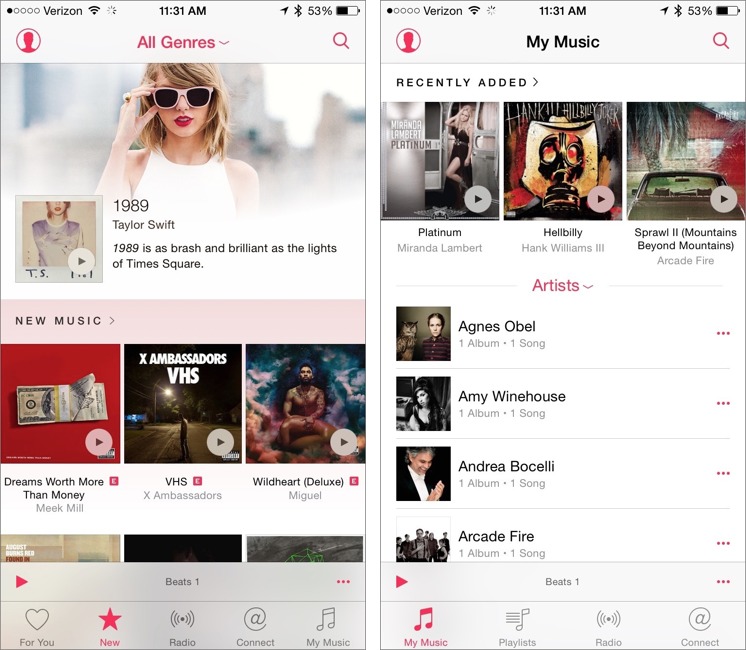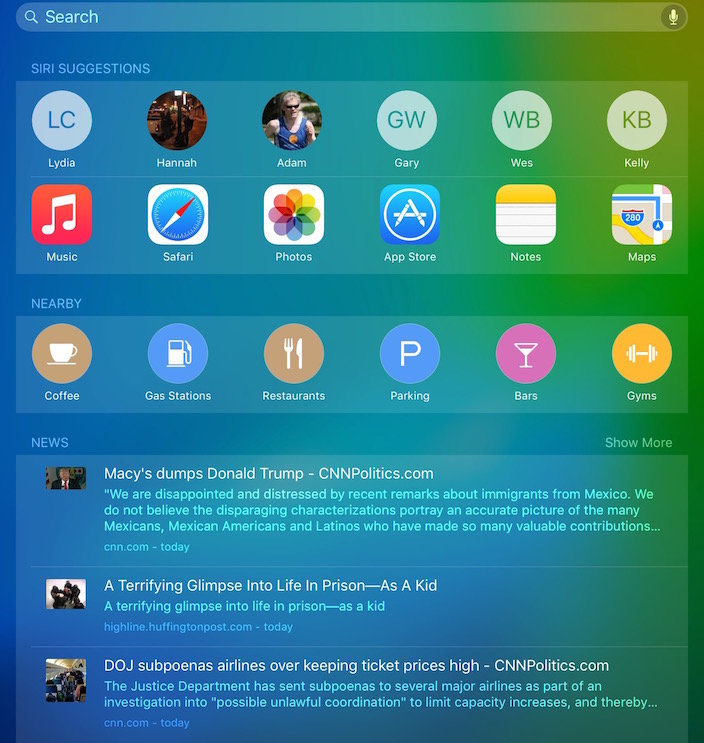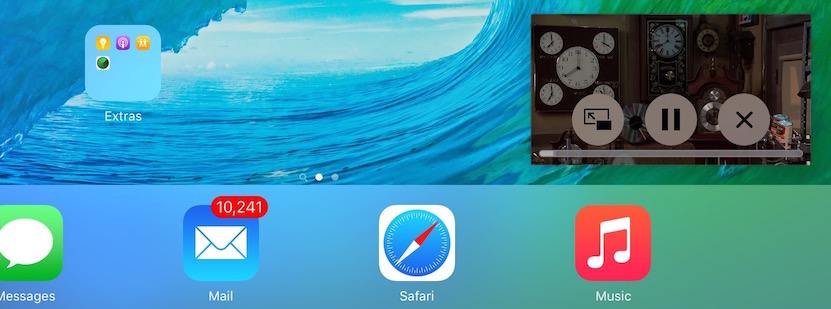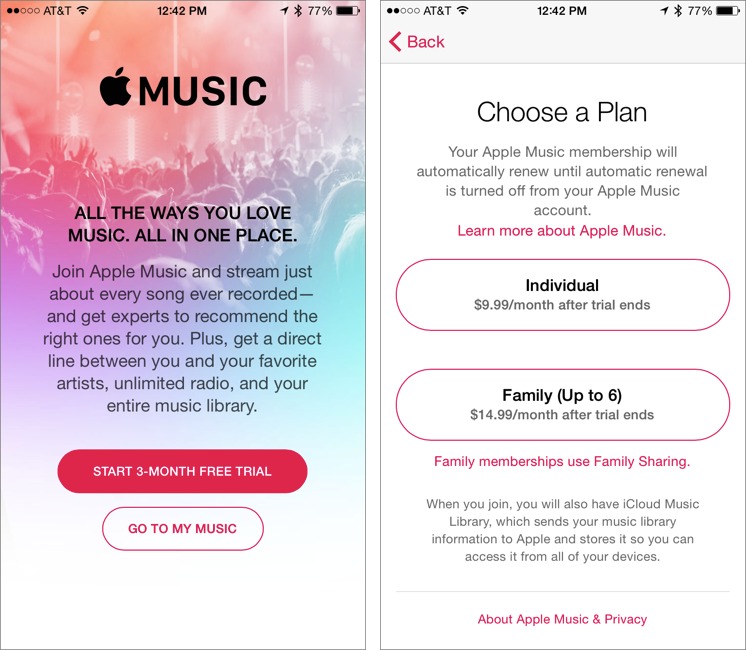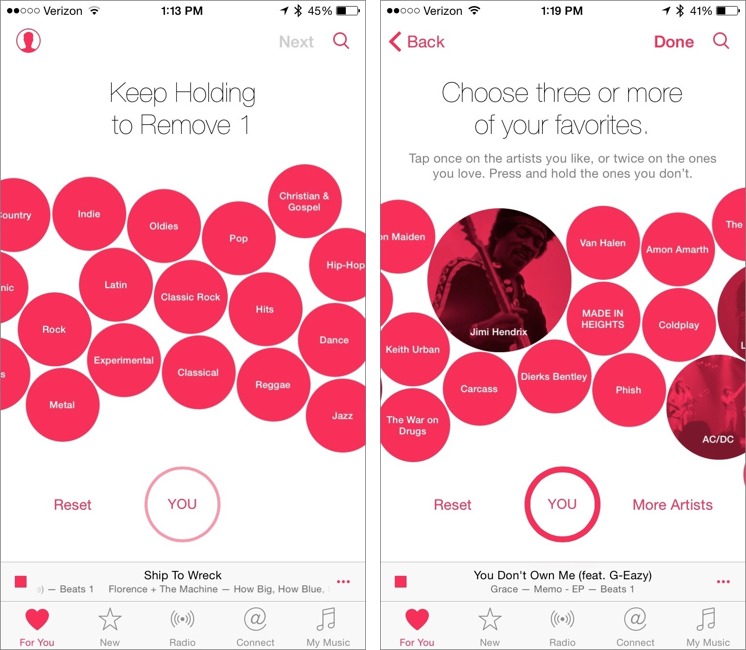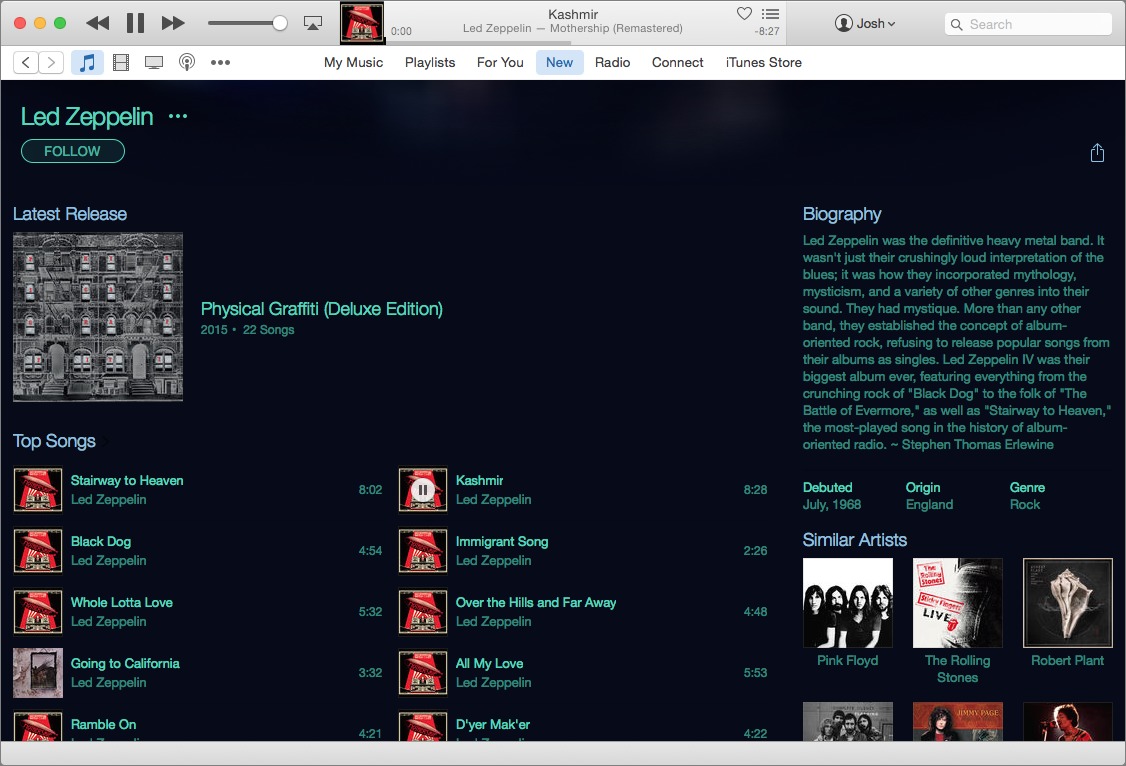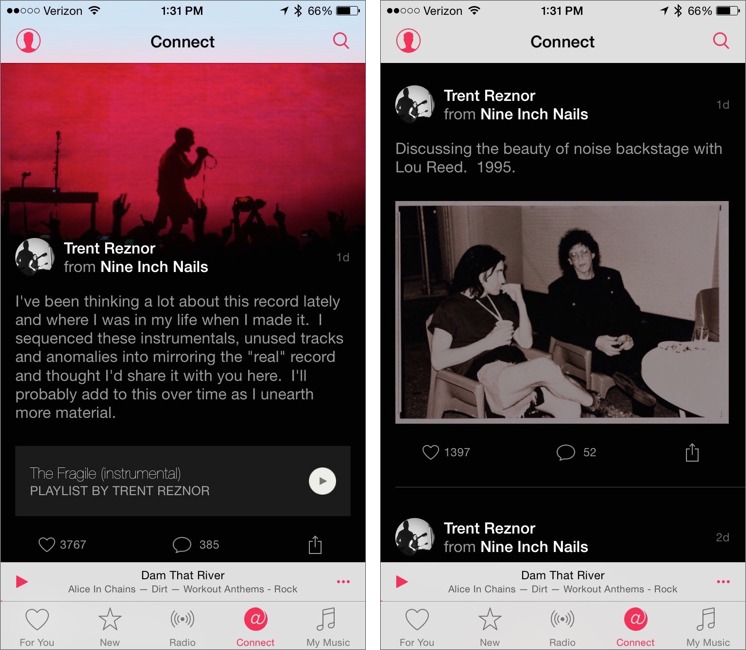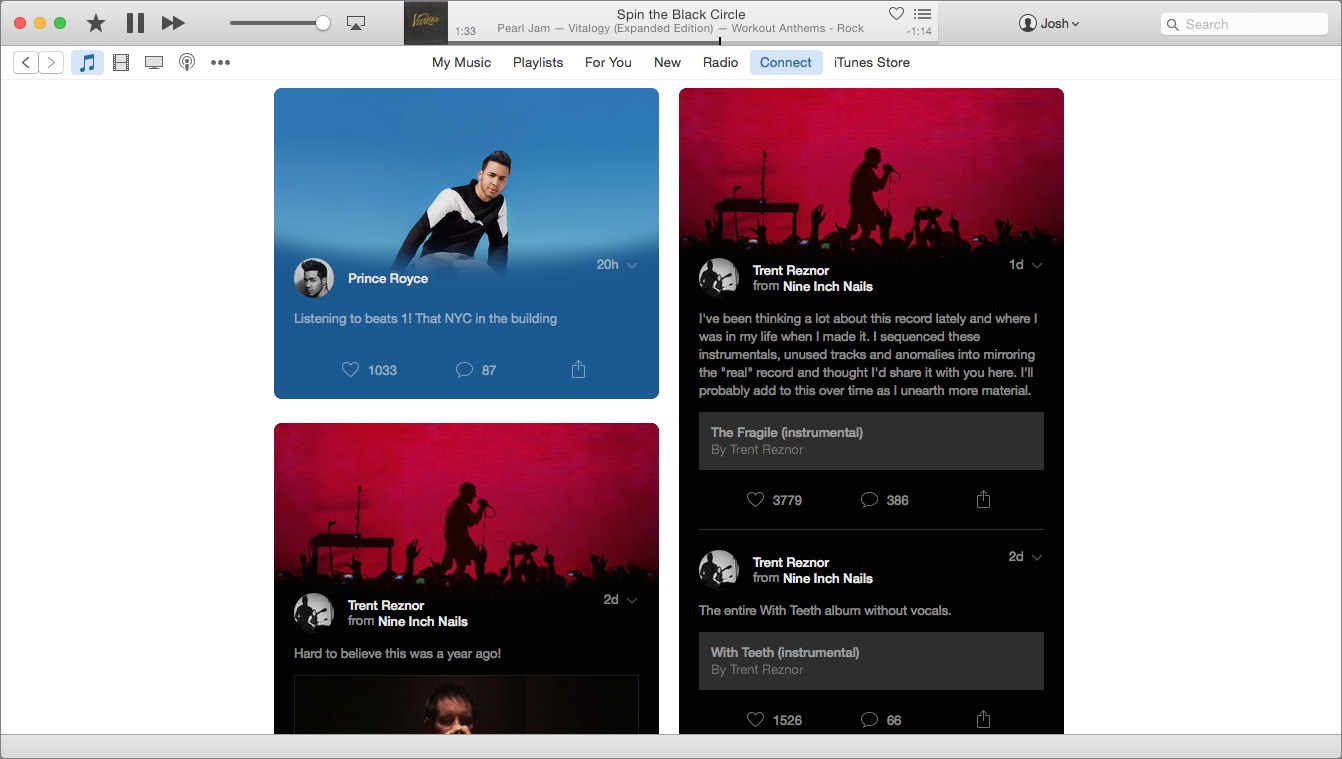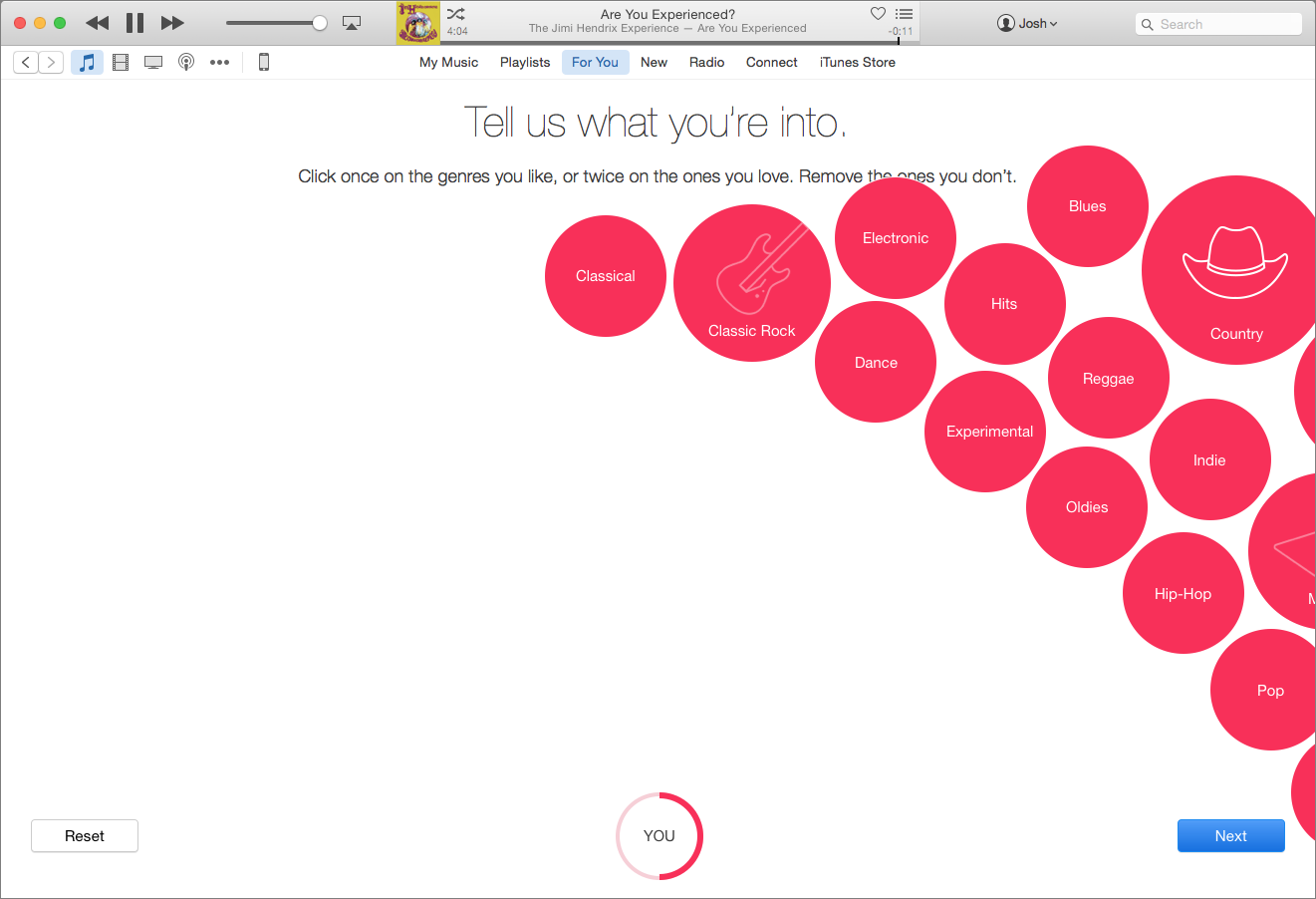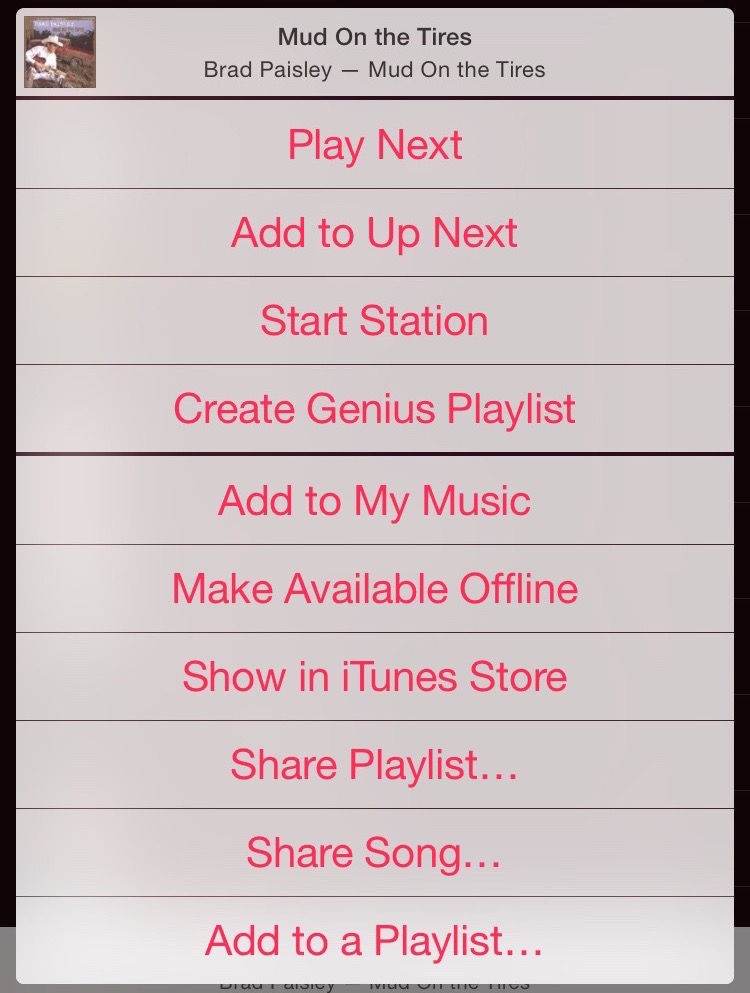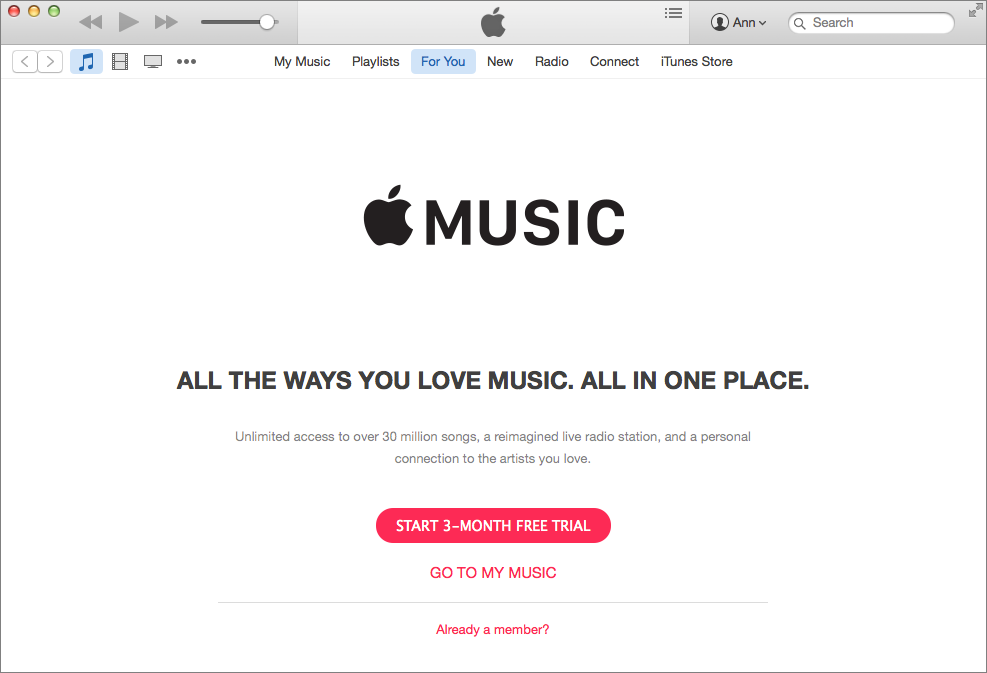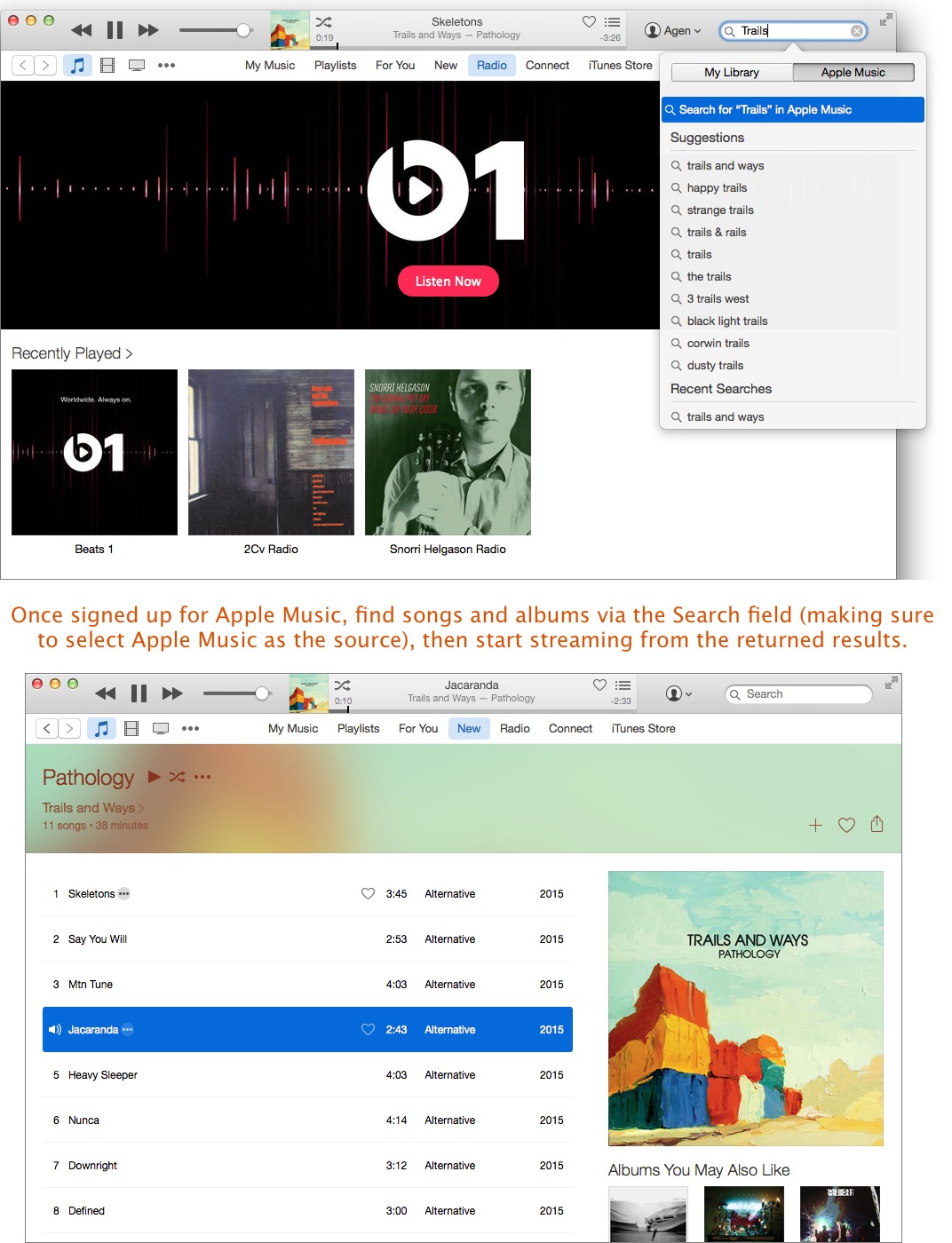TidBITS#1279/06-Jul-2015
With other TidBITS writers on vacation, Josh Centers stayed behind to keep the home fires burning, where he handled the yeoman’s work of covering Apple’s releases of OS X 10.10.4 and iOS 8.4. He also found the time to provide a tour of some of the more subtle features of the just-released Apple Music streaming service, and to track down clues to the next-generation Apple TV in the forthcoming iOS 9. Notable software releases this week include Voila 3.9, Typinator 6.6, GarageBand 10.1, iTunes 12.2, Security Update 2015-005, Mac EFI Security Update 2015-001, and Safari 8.0.7, 7.1.7, and 6.2.7.
Apple Improves Networking in OS X 10.10.4
If you’ve been plagued by networking problems since updating to OS X 10.10 Yosemite, your salvation may be at hand with the OS X 10.10.4 update, which ditches the unreliable discoveryd service for the trusty old mDNSResponder. In plain English, that should mean the return of stable networking in OS X (see “Apple’s Networking Kerfuffle,” 7 May 2015).
You can install 10.10.4 via Software Update, or from Apple Software Downloads as delta (1.09 GB) and combo (2.02 GB) installers. As always, it’s smart to wait a few days to see if any major issues crop up, but if you’ve been nagged by networking problems, an immediate upgrade may be advisable. Be sure to back up first!
In the world of Photos, we’re hoping OS X 10.10.4 addresses the sync issues brought up by Adam Engst in “How to Throttle iCloud Photo Library Uploads” (20 May 2015) and “More Problems with iCloud Photo Library Uploads” (19 June 2015). Apple mentions fixes like “improves reliability when syncing photos and videos to iCloud Photo Library,” and “improves the reliability of upgrading iPhoto and Aperture libraries to Photos.” Also, 10.10.4 fixes an issue that could cause Photos to crash after importing some Leica DNG files.
Additionally, OS X 10.10.4 improves the reliability of Migration Assistant and addresses an issue that prevented some external displays from functioning properly. There are also fixes for delayed outgoing messages in Mail and an issue that allowed Web sites to prevent users from navigating away in Safari by presenting repeating JavaScript alerts.
For enterprise customers, OS X 10.10.4 has a fix for an issue where Macs bound to directory services could stop responding under certain conditions. Also, the update grants the capability to create mobile accounts with the createmobileaccount command-line tool and fixes an issue in Profile Manager that could allow users to install pre-release software even when the setting was disabled.
As always, OS X 10.10.4 also includes numerous security fixes.
Apple Releases iOS 8.4 with Apple Music
Apple has released iOS 8.4 alongside the company’s promised Apple Music service. You can download the update via Settings > General > Software Update or through iTunes.
The first thing you may notice in iOS 8.4 is the funky new Music icon. But the changes go beyond just the icon: the entire Music app has been redesigned around Apple Music. When you first launch Music after updating, you will be asked if you want to sign up for the three-month Apple Music trial. You can skip this if you like.
There are now two interfaces for Music, depending on whether or not you subscribe to Apple Music. If you subscribe to Apple Music, the Music app offers five views:
- For You, which recommends new music based on your tastes
- New, which showcases new music
- Radio, the home of the new Beats 1 radio station, as well as your iTunes Radio stations
- Connect, a new social feature that lets you follow artists
- My Music, where you access your own music
If Apple Music is disabled, then there are just four views: My Music, Playlists, Radio, and Connect. Despite being part of Apple Music, Radio and Connect are free for everyone. You can turn Apple Music on and off in Settings > Music > Show Apple Music.
There are other refinements in Music as well, such as a MiniPlayer, which lets you keep on eye on what’s playing as you navigate the app; Up Next, which lets you see and rearrange queued music; and Recently Added, which displays recently added songs and playlists in My Music.
But all the love didn’t go to Music; iBooks also sees some major improvements. iBooks now supports audiobooks, enabling you to purchase and play them within iBooks on your iOS device. Also, books created with iBooks Author (also known as “Made for iBooks”) now work on the iPhone in addition to the iPad. You can now pre-order a book series directly from your library. Other miscellaneous improvements include better accessibility of widgets, glossary, and navigation in books made with iBooks Author, and a new default Chinese font. iOS 8.4 also fixes bugs that prevented Hide Purchases and iCloud book downloads from working.
In other bug fixes, iOS 8.4 resolves the problem where a specific series of Unicode characters could cause devices to reboot, fixes a bug that prevented GPS accessories from providing location data, and addresses an issue where deleted Apple Watch apps could reinstall themselves.
As always, there are oodles of security fixes.
We’re not hearing of any early problems, so it’s probably safe to install whenever you have the time.
Finding Clues to the Next Apple TV in iOS 9
As an Apple TV aficionado, I’m a bit bummed out. The third-generation model is now three years old, and it has grown so long in the tooth that Amazon’s Fire TV has taken the top position in our living room. I was hoping to spend this summer writing an update to “Take Control of Apple TV,” but the WWDC keynote gave us nothing new on that front, though the Apple TV is now $30 cheaper. Even Apple’s new Apple Music service has left the Apple TV out in the cold so far.
Even while I was originally drafting “Take Control of Apple TV,” I lived in constant fear that a new version would come along, forcing a rewrite. And then for months after, I kept expecting a new one, discussing it on podcasts and here in TidBITS (see “The Future of Apple TV,” 21 February 2014). But nothing came. Have I become like Piper Jaffray analyst Gene Munster, who for years tilted at the windmill of an Apple television set?
No. Something is coming, and there are clues in the upcoming iOS 9, just as iOS 8 offered clues about the Apple Watch. But first, let’s chase an elephant out of the room before we have a major cleanup job on our hands…
Apple TV’s Not an Ex-Parrot — Let me first dismiss the notion that Apple is discontinuing the Apple TV. Yes, the March price drop could have been interpreted as a liquidation, but there’s no lack of Apple TVs for sale now, months later (see “Apple Announces HBO Partnership, Cheaper Apple TV,” 9 March 2015). And why bring HBO on stage to announce Apple’s (short-lived) HBO NOW exclusivity if Apple’s main living room device was nailed to its perch?
There’s a single clue in the upcoming OS X 10.11 El Capitan to prove that the Apple TV hasn’t kicked the bucket: AirPlay support in Safari. Why would Apple add that feature, much less showcase it in the WWDC keynote and on its Web site, if the company was about to axe the only product it sells that can take advantage of AirPlay video?
You might say, “But the AirPort Express acts as an AirPlay receiver!” True, but it doesn’t do video. Here’s Apple’s description of AirPlay in Safari: “Play video from a web page to your TV with Apple TV — without showing everything else on your desktop. Just click the AirPlay icon that appears on compatible web videos and you can watch your video on the big screen.” I added the emphasis on video there, because Apple mentions it three times. Maybe the feature will support audio streams as well, but video is clearly the emphasis, and the only Apple-sanctioned AirPlay video receiver on the market is the Apple TV.
Still not convinced? OK, maybe the Safari team isn’t necessarily talking to the Apple TV team. Maybe the Apple TV is already pining for the fjords and the Safari folks just don’t realize it yet? But surely the marketing team would know something, at least enough to not mention AirPlay.
I have even more evidence. HomeKit, iOS 8’s long-delayed home automation framework, uses the Apple TV as a gateway device. From Apple’s support document on HomeKit:
If you have an Apple TV (3rd generation or later) with software version 7.0 or later, you can control your HomeKit-enabled accessories when you’re away from home using your iOS device.
Sign into iCloud with the same Apple ID on your iOS device and Apple TV, and you’ll be able to use Siri commands to remotely control your accessories. If your remote access isn’t working, sign out of iCloud on your Apple TV, then sign back in.
While HomeKit was announced over a year ago, it only recently became available to users, so why would Apple make the Apple TV HomeKit’s gateway into the home if it had joined the choir invisible? Apple makes some curious decisions, but (to switch from Monty Python references to “The Princess Bride”) that’s just inconceivable.
Even more curious is why the Apple TV is being used as the gateway. Wouldn’t using AirPort base stations make more sense, since those already act as Internet gateways? I think HomeKit is a clue about bigger things to come for Apple TV.
Maybe you’re still unconvinced. Well, at this point, I doubt anything I say can make you a believer. But, can you explain why Apple recently gave the Apple TV its own section in the Apple Store after years of burying it? Also, consider this: the Apple TV is the only inexpensive, user-friendly way to display iTunes content on your TV. Regardless of how popular or profitable it is, it’s an essential piece of Apple’s overall ecosystem. And Apple still ships more Apple TVs than digital media streaming
devices sell from Roku, Google, or Amazon.
No, the Apple TV is not dead. It’s merely resting.
The Clues — If the Apple TV is not pushing up daisies, what might be in its future? Clues abound in Apple’s recent operating system announcements.
While Apple still struggles to maintain both OS X and iOS at the same time, it has found ways to build synergies between its operating systems. Features will be developed on one platform, and later move to others. The most blatant example of this was Mac OS X 10.7 Lion, in which many iOS innovations went “back to the Mac,” and the most recent example is Force Touch migrating from the Apple Watch to the MacBook line. I bet the next iPhone will support Force Touch as well.
iOS 8 offered a number of clues about Apple’s watch ambitions. Widgets, interactive notifications, voice messages, Health, and Handoff all foreshadowed significant aspects of watchOS. And even though not every iOS 8 feature appeared in watchOS, some showed us what Apple was thinking, like contact shortcuts in the app switcher.
Just as iOS 8 offered clues about the Apple Watch, I think iOS 9 contains clues about Apple’s thinking about the next-generation Apple TV.
One of the biggest complaints about streaming boxes like the Apple TV is that search is a mess. Let’s say you wanted to watch the brilliant, but recently cancelled, show “Hannibal.” Since the Apple TV offers no system-wide search, you have to dive into each app to see if the show is there. After a bit of digging around, you might figure out that it’s for sale in iTunes and recent episodes are on Hulu Plus, but it will take some work.
Things are slightly better with the Fire TV, since it has both system-wide search and voice search. So with a word, you’d discover that “Hannibal” is available on Prime Instant Video. But what about shows not on Prime? That gets more complicated. Amazon’s search will direct you to shows on Hulu Plus, but not Netflix.
Thankfully, iOS 9 offers a solution: in-app search. Thanks to a new Spotlight API, developers will be able to tie their apps’ data into the system-wide search. For example, searching Spotlight for “bacon” might bring up a number of bacon-related recipes in Paprika.
How great would this be on the Apple TV? With in-app search, you could use a single search box to find out that “Hannibal” is available in iTunes, Hulu Plus, and on Amazon Prime Instant Video. OK, that last one is a stretch, but a guy can dream, right?
Another new search feature in iOS 9 is Siri Suggestions. When you enter Search by sliding to the left-most screen, iOS 9 offers a number of suggestions immediately, including recent contacts, recently used apps, nearby places, and news items.
Imagine Siri Suggestions on the Apple TV. Bring up Search, and it might recommend recently watched TV shows, suggested shows and movies, and maybe even suggested music, if you subscribe to Apple Music. Siri Suggestions on the Apple TV could even have its own news section, with video links to the day’s top stories.
Speaking of Siri, it has some interesting new features in iOS 9 that could also be useful on the Apple TV. You’ll be able to search for photos and videos with Siri, so you can say, “Show me photos from San Francisco,” or “Show me videos from August 2013.” Combined with iCloud Photo Library, that would be a handy feature on the Apple TV. You can also tell Siri to remind you of something you’re currently looking at in iOS 9. So you could tell Siri on an Apple TV, “Remind me to watch this later” while viewing a movie listing.
A new iPad feature in iOS 9 is a natural for the Apple TV: picture-in-picture. When you’re watching a video on the iPad in iOS 9, if you press the Home button, the video keeps playing, shrunk down to a small window in the lower-right corner of the screen. You can move and resize this window, as well as use in-window controls to play or pause the video, restore it to full-screen, or dismiss it. This would be great on the Apple TV, as you could keep watching a video as you’re browsing around the interface, looking for the next thing to watch.
Outside of iOS 9, the beta for OS X 10.11 El Capitan also holds a possible clue about the next Apple TV. Mark Gurman of 9to5Mac discovered a settings file that references a new Apple Remote with a multi-touch trackpad, infrared sensor, and possibly Force Touch. These sorts of hidden device references have been discovered before, and are usually accurate indicators of upcoming products, though I’m not holding my breath.
So Where Is This New Apple TV? — If Apple hasn’t killed the Apple TV, but has instead spent years developing something new and possibly revolutionary, then where the devil is it?
My guess, based on the rumor mill, is that the holdup is in negotiations with content providers. Piecing together the rumors, the story seems to be that Apple had originally planned the next Apple TV to act as a cable box, but negotiations with cable companies, especially Comcast, soured. Apple then pivoted to an Apple TV based around a Sling TV-style service, which was planned to be unveiled at this year’s WWDC keynote, but negotiations with content providers hit a last-minute roadblock (for more on Sling TV, see “FunBITS: Sling TV Is Made for Cord Cutters,” 20 February 2015). Some have speculated that the absence of the Apple TV was why the Apple Music introduction was so long and
haphazard. I’m not sure I buy that, since Apple sets its own schedule for events, but it’s believable that a last-minute change to the keynote led to a bit of chaos.
I’m not sure how true this story is, but it makes sense. Apple could have easily introduced a new Apple TV with the same software years ago. But Apple usually likes to have a software story to tell alongside new hardware, and when it comes to TV, content is king. The content and distribution side of the TV business is notoriously complex, and every media company has an entirely reasonable fear that Apple will take control if given the chance.
But enough Kremlinology. I’d like to address a question that I’m asked repeatedly by readers: should you buy an Apple TV now, or should you wait?
It’s based on the fear that Apple will release a new Apple TV any day now, instantly making your $69 purchase obsolete. Chances are that if Apple were to release a new Apple TV this year, it would be sometime in September, to coincide with new iPhone and iPad releases. As I write this, that release is probably about two months away.
I’d counter with this question: do you need a new Apple TV right now? There are two things an Apple TV can do that no other set-top box can: play video content from the iTunes Store and act as an AirPlay receiver (there are AirPlay hacks for most set-top boxes, but you’ll be hard-pressed to find a reliable one). If you need those features sooner rather than later, go ahead and plunk down your $69. Even if a new model is released, the old third-generation model should keep doing those things for years. (That said, I wouldn’t bother replacing a second-generation Apple TV with a third-generation model — it’s just not enough of an upgrade to justify the cost.)
Ultimately, $69 is chump change in the Apple hardware world. Even if you buy a new $99 Apple TV in a few months, you’d be out only $168 before tax, which isn’t much compared to even an Apple Watch. And that old Apple TV may still be useful with a second TV, or converted into an audio AirPlay receiver. Who knows, maybe you won’t like the next Apple TV, or it’ll be plagued by launch bugs. The existing Apple TV works fine now, even if it’s a bit dusty.
If you don’t need iTunes video or AirPlay, and want something now, I’d suggest looking at alternatives. A lot of people like Roku’s products, and the Fire TV has grown on me since I wrote “Fire Watch with Me: Amazon Fire TV vs. Apple TV” (13 May 2014).
But I miss AirPlay, and I like being able to control the TV with my Apple Watch. So Apple, whatever the holdup is, please get it resolved so we can have a new Apple TV sometime this year!
A Tour of Apple Music
Apple Music has launched with much fanfare, giving iOS and Mac users access to streamed music from the iTunes Store, iCloud-based synchronization of your existing music library across multiple devices, the Beats 1 streaming radio station, and the Connect service for interacting with artists.
As soon as you open the Music app in iOS 8.4, you’re invited to join the new music streaming service, with a free three-month trial as an enticement.
Naturally, I’m going to assume that you did just that, because hey, why not? For that reason, I’m not going to bore you with a detailed walkthrough and review, because much of it is obvious and you can easily decide for yourself if the service is for you.
However, not everything about Apple Music is obvious, and let’s be honest, the company did a horrible job of describing it at the WWDC keynote (see “Apple Announces Apple Music Service,” 8 June 2015), so I’d like to share a number of tips and observations so you’ll get the most out of your three-month trial.
Individual or Family? — When you’re signing up for Apple Music, you have to make a decision: do you want an individual membership for $9.99 per month or a family membership for $14.99 per month?
Here’s what to consider. The family membership allows up to six people to share your Apple Music membership, all while maintaining their own profiles and preferences. But there’s a catch: it can be shared only within your Family Sharing circle.
As we explained in “iOS 8: TidBITS Answers Your Questions,” (17 September 2014), Family Sharing is a feature that lets you share App Store, iTunes Store, and iBooks Store purchases with up to five other people in your immediate family. But it doesn’t include iTunes Match and has other drawbacks too, as pointed out by Mac blogger David Sparks.
If you have more than one person in your household who will want Apple Music, the family membership is a no-brainer… unless you don’t use or want to use Family Sharing. In that case, the calculus becomes more complex. Your family members could each choose to have individual plans, for $9.99 per month, but that gets expensive fast.
You might think you could share an account if you and your spouse have similar tastes, for instance, but since the individual membership allows you to stream to only one device at a time, it may be awkward if your desired play times (in different locations or on different devices) overlap.
Turn Off Auto Renewal — With the three-month free trial, Apple is being generous, but also sort of sneaky, since by default, the company will begin charging you automatically once your trial is over. Here’s how you can prevent that in iOS.
- Open the Music app and tap the head icon in the upper left.
- Tap View Apple ID.
- Enter your Apple ID password.
- Under Subscriptions, tap Manage.
- Tap Your Membership, which should show an Active status.
- Disable Automatic Renewal.
Or in iTunes:
- Choose Account > View Account.
- Under Settings, find Subscriptions, and click the corresponding Manage link.
- Click Edit, to the right of Your Membership.
- Under Automatic Renewal, select Off.
- Click Done.
Whew, that was a surprising number of steps! Whatever happened to “no step three?”
Note that even if you do not decide to stick with Apple Music, Beats 1 and Connect are free, and will remain available.
Behind the Music — In iOS, Settings > Music offers some settings that may interest you.
The first is Show Apple Music, which toggles the Apple Music interface in the Music app. As I mentioned in “Apple Releases iOS 8.4 with Apple Music” (30 June 2015), the Music app has two distinct interfaces, depending on whether or not Apple Music is enabled. So if for whatever reason, you want to revert to the “normal” Music interface, you can do so with this switch.
The second is iCloud Music Library, which you may have some trouble enabling, due to Apple’s server overload. If you’re persistent, it will eventually stick. But what does it do?
iCloud Music Library essentially replaces iTunes Match, although iTunes Match is still offered as a separate product. As the name suggests, iCloud Music Library is just like iCloud Photo Library, but for your music. Whatever songs and playlists you add to My Music on one device will be synced to the others, at least in theory. I’ve found that it works pretty well, uploading or matching all of my music, without clogging my Internet connection like iCloud Photo Library.
Although I let my iTunes Match subscription expire months ago, those tracks were apparently still stored in iCloud, as iCloud Music Library synced those to the iPhone hours before the iTunes update arrived.
But there is a major catch, and a reason why iTunes Match still exists: when iCloud Music Library syncs your tracks, those new files are encumbered by DRM, and will vanish when your Apple Music membership expires. So, if you upload your music library, delete it for some reason, and then cancel Apple Music, you will suddenly find yourself with no music library at all. Or, even if you don’t cancel Apple Music, if you delete your main music library, the tracks you’d get from iCloud Music Library would all have DRM on them. In other words, don’t delete your main music library, and don’t assume that iCloud Music Library is a
backup, since it’s not.
The good news with iCloud Music Library is that the service is offered to everyone in your Family Sharing circle, so it solves the aforementioned problem of iTunes Match not being included in Family Sharing.
Customize, Customize — The For You view suggests albums and playlists tailored to your tastes. To get started, tell Apple Music which genres you like and don’t like by tapping the buttons. If you’re familiar with Apple Music’s ancestor, Beats Music, this screen will look familiar. Tap a genre bubble once to indicate that you like it, and watch the bubble grow. Tap it again to indicate that you love it, and watch it grow even larger. To delete a genre entirely on iOS, press and hold a bubble; a countdown appears, after which the bubble vanishes. In iTunes, just click the “x” on the button. If you make a mistake, you can tap Reset to start over.
Next, you’ll be prompted to voice your preference on specific artists, using the same bubble interface. I found this part frustrating, as the selection of artists was limited, and mostly outside of those I listen to. Yes, I love Jimi Hendrix and like Van Halen, but they’re not artists I listen to every day.
Thankfully, Apple Music is smarter than it seemed. It figured out that if I like Hendrix and country, then I’d probably also like Johnny Cash and Willie Nelson. Some of its other suggestions are more perplexing, and I hope it will improve over time. Others, such as designer Khoi Vinh, have had less than stellar results; he’s unimpressed that Apple couldn’t do better out of the gate, given how much data the company has available about our
musical preferences.
If your tastes change over time, you can rejigger them, at least in Music on iOS. Tap the head icon in the upper left, and tap Choose Artists For You to change your preferences.
You can also tailor your preferences on the fly. Tap the heart on a song or a playlist to tell Apple Music that you like it. That heart is now a prominent icon across all of Apple’s music platforms, including iTunes and even the Now Playing glance on the Apple Watch.
Unfortunately, there is no list of favorited songs and playlists. To add a song to your music collection, you either need to tap the + button or tap the … button and choose Add to My Music. I think Apple should have combined these two buttons, because if I like a song, why wouldn’t I want it in my collection?
35 Million Songs and Nothing to Listen to — You might recall from “A Visit to Pandoland, Where Silicon Valley Meets Music City,” (20 June 2015), Marc Ruxin of Rdio pointed out that the biggest challenge that music streaming services face is “35 million songs and nothing to listen to” — meaning that users are often left to their own devices to discover music they might like.
Like Rdio, Spotify, and similar music streaming services, once you subscribe to Apple Music you’re free to listen to whatever you want, with some limitations. Apple has been cagey about just how many tracks Apple Music offers (it’s not the full iTunes Store catalog), but I’ve found the selection to be as good as, if not better than, any of its competitors. Apple Music already has a few exclusives, such as Dr. Dre’s “The Chronic” and Taylor Swift’s “1989” that you won’t find on any other streaming service. It also has Led Zeppelin, which was previously available only on Spotify. However, it doesn’t yet
have The Beatles.
When you find an artist, like Beats Music before it, Apple Music gives you a detailed artist bio and recommends similar artists.
But Apple Music goes even further in trying to find stuff for you to listen to, and here’s where its roots in Beats Music shine. There’s the aforementioned For You section with personalized recommendations. There’s the New section, with a smorgasbord of newly added content. iTunes Radio is still sort of there, as well, though it has been somewhat neutered (see Missing Features below).
The human-curated playlists of Beats Music are still around, so there’s stuff like “Intro to Taylor Swift” that gives you an overview of an artist’s work. There are thousands of available playlists, some incredibly specific, like “Somethin’ ‘Bout a Truck: Country Pickup Truck Songs” and “Workout Anthems — Rock.” Dig around enough, and you’re sure to find a playlist you’ll love.
And there’s also Beats 1, Apple’s live, worldwide radio station with human curated content.
Beats 1 Killed the Video Star — Of all the features in Apple Music, Beats 1 might be the most fascinating, despite being an old idea: a live radio station manned by human DJs.
Many online commentators have rolled their eyes at Beats 1, making the joke that Apple has now “invented” FM radio. As someone with an analog Sony pocket radio on his desk, I say these snarky commenters are missing the point.
Chances are, outside of college radio, it has probably been decades since you listened to a radio station where the DJs actually picked the music. As radio stations consolidated, music selection was ripped from the DJs’ hands, decided instead by computer algorithms and the marketing departments of record labels. You’ll rarely be surprised by what’s played on the radio. Here in the Nashville broadcast area, some of the country stations are so pre-planned that you can literally set your watch to them.
What Beats 1 brings is the unexpected. I happened to catch Zane Lowe’s Beats 1 kickoff. Lowe gave a brief rundown of the philosophy of Beats 1 before playing the first song. “It’s not about fanfare, that’s fireworks and a hangover the next day. It’s about quality and consistency,” he said before kicking off Beats 1 with “City” by Spring King.
It was a surprising choice, and one that I think few listeners had previously heard. He followed it up with the new Beck single, “Dreams,” then later brought out AC/DC’s “For Those About to Rock.” Throughout the first day, I kept tuning into Beats 1, never knowing what I’d hear next. Sometimes it was hip-hop, sometimes electronica. I never heard country, jazz, or classical, but I wouldn’t be surprised if they were slipped into the mix at some point.
I’ve also heard some folks say, “Beats 1 doesn’t play anything I like.” To me, that’s the equivalent of asking, “Where’s my parade?” You’re not going to like every song played on Beats 1, and that’s kind of the point (though, of course, those who find they dislike most of what Beats 1 plays are unlikely to tune in more than once). Beats 1 exists to expose you to stuff you otherwise wouldn’t know exists. If you have highly specific tastes in music, Apple Music offers plenty of other options for you.
What makes Beats 1 exciting is personality. Like any great media venture, its beginnings feel rough around the edges. The playlists are haphazard, the DJs say crazy, off-the-cuff things like, “I’m going to take your kids away and give you a headphone moment,” and in true Apple fashion, there was an outage on the first day. It doesn’t feel like a media venture from the world’s biggest company, but instead like a pirate radio station down the street. In a word, it’s fun.
The other great thing is the social factor. Beats 1 provides a single, shared experience, so you can go on Twitter and Facebook and have a conversation about the thing you’re listening to. In today’s fragmented media world, Apple might be one of the few companies that can provide a shared experience for millions of people.
I’ve also found that Beats 1 acts as a home base for Apple Music. It’s what I turn to when I can’t think of anything to play.
Some have said that Beats 1 is very unlike Apple, but I disagree. It perfectly mixes technology and humanity, and isn’t that Apple’s very core?
Like any other radio station, you can request a song. Apple World Today has compiled a list of all the ways to request a song, including a Twitter hashtag, iMessage, and even old-fashioned phone lines.
Another neat feature of Beats 1 is a weekly show, hosted by singer St. Vincent, where she creates a custom playlist for a random lucky fan. How’s that for personalization?
Note that Beats 1 censors explicit content from the songs it plays. Some have complained about that, but it’s a smart move. Parents can play Beats 1 with their kids in the car, and businesses can play Beats 1 without fear of offending customers. If you want to hear explicit content, you can find the uncensored songs on Apple Music.
Hello Connect, My Old Ping — The last major component of Apple Music is Connect, a social network where you can follow your favorite artists. You might remember its first incarnation, Ping.
Ping lived a short, unhappy life, and to this day, it’s still the butt of jokes. But Ping wasn’t a terrible concept, it was just executed terribly. It added clutter to iTunes without much value. As much as we like each other, my wife and I have very different musical tastes, so even we seldom care about what the other is listening to.
Connect is more subdued than Ping. First of all, it lives in its own pane, out of the way. Second, while there isn’t much there yet, what’s there is actually interesting. For example, Trent Reznor of Nine Inch Nails, one of the brains behind Apple Music, has posted instrumental versions of some of his albums, a concert video, and a backstage picture of himself with Lou Reed. Nothing earth-shattering, but hardcore Nine Inch Nails fans were thrilled.
Out of the gate, Connect automatically follows every artist it can find in your iTunes library. To change who you follow on iOS, tap the head icon in the upper left and tap Following. Then you can choose to stop following artists automatically, find more artists and curators, and unfollow artists.
Happily, if you don’t care about Connect, you can disable it entirely in Settings > General > Restrictions > Apple Music Connect. You will have to enable restrictions, but that in itself doesn’t do anything other than allowing you to enable individual restrictions. Disabling Apple Music Connect replaces the Connect tab with a more useful Playlists tab.
Missing Features — Apple Music is essentially the love child of iTunes and Beats Music, so it was inevitable that the kid wouldn’t have all of the features of both of its parents.
One of Beats Music’s unique features, The Sentence, is absent in Apple Music. As you may recall from “FunBITS: What Sets Beats Music Apart” (16 May 2014), The Sentence let you create custom playlists by filling in the blanks in a Mad Libs-style interface. So you could create a sentence like “I’m in the club and feel like saving the world with no regrets to indie.” I can see why Apple dropped it, as it was as baffling as it was novel, but I’m still sad to see it go. I hope Apple eventually brings it back in some form, with Siri support.
Another Beats Music innovation I miss is the circular scrubber around the play/pause button for rewinding and fast-forwarding. Again, I see why Apple dropped it for something more familiar, but I liked it, as it reminded me a bit of the iPod click wheel.
There’s one last missing feature that grinds my gears. Remember iTunes Radio, Apple’s Pandora clone that would play music related to a particular song or artist? It still exists, but is barely recognizable. Previously, you could start adding a new station, specify an artist or song you like, and then create your station, but now it’s not as obvious. Don’t worry, though; your existing stations are still there.
You can still create a custom station, but you do so by searching for an album, artist, genre, or song, scrolling down to the Stations heading, and then choosing that station. For instance, if I wanted to make a station based on “Where Is My Mind?” by the Pixies, I would search for that song, scroll down, and then tap Where Is My Mind? Radio under the Stations heading. You can also create a station directly from a song you’re listening to. On those custom stations, you can tap the star (which replaces the heart) while listening to tune the station to play less of or more of that type of music.
There’s another way to create a custom station on the fly: Siri. Just tell Siri something like “play AC/DC radio.” In fact, one of the best things about Apple Music is its Siri integration, which makes possible commands like “play Beats 1” or “play 1989” (where Siri guessed at Taylor Swift’s new album correctly, despite the ambiguous name).
But outside of favoriting tracks, the rich editing options previously available in iTunes Radio are gone. Want to exclude Nickelback from your rock station? Too bad, so sad. This is a huge step backwards, for no good reason.
To make things confusing, Apple has also added human-curated stations, like Pure Pop and The Mixtape, which cannot be customized.
Jim Dalrymple has explained Apple’s radio reasoning. The idea behind the curated stations is that Apple doesn’t want you to worry that favoriting or skipping a song will mess up your station. Apple hopes that the new curated stations will produce more songs you like, resulting in fewer skips. However, if you’re listening to a station you created yourself, or a station you started by searching for a specific artist or song, the heart becomes a star, and tapping the star while listening to a song gives you options to play more or less of that kind of song. So you can’t fine-tune the Classic Rock station, but you can tailor Hank Williams
Radio. I understand Apple’s reasoning, but I still miss the more detailed per-station settings.
Going back to missing features, as I write this, Apple Music isn’t yet appearing on the Apple TV. On the upside, you can still customize your iTunes Radio stations there. Poor Apple TV, why has Apple forsaken thee? Apple Music support is surprisingly spotty on the Apple Watch. You can control playback and favorite songs from the watch, but you can’t directly access any content not specifically added to My Music, including Beats 1.
WTF, iTunes? — iOS 8.4, with Apple Music support, launched on 30 June 2015 at 11 AM Eastern time, which was crucial, because Beats 1 launched one hour later. iTunes 12.2, which brought Apple Music to the Mac, didn’t appear until several hours later, at the end of the day (see “iTunes 12.2,” 1 July 2015).
Many assumed that there was some snafu at Apple’s end, but I think it was a deliberate decision. While Apple Music in iOS is a pretty good experience, it is a train wreck on the desktop. And I stop at “train wreck” only because TidBITS is a family friendly publication.
Start with iTunes 12’s labyrinth of an interface. Now, add three new tabs when Music is selected on the left: For You, New, and Connect. That’s the baseline.
From there, add in the fact that Apple Music was clearly designed as mobile first, with the desktop a distant afterthought. Look at all the white space in the Connect pane.
Then, stir in a good dose of bugs. For example, when I checked my For You preferences, the bubbles inexplicably drifted to the right side of the screen, and even off of it. I started to wonder if my desk was level.
Finally, there’s the fact that iTunes is missing a number of Apple Music settings. There’s no way to change who you’re following in Connect, or any way to change your For You pane from iTunes. Those capabilities exist only in iOS. To say that Apple Music feels like an afterthought on the Mac is being kind.
Apple, this is sloppy work at best. It would have been better to hold off on releasing Apple Music on the desktop than to release it like this. Perhaps the problem is iTunes, which needs to be rethought completely. It’s a program that was originally designed for ripping, sorting, and playing MP3s that has since had grafted onto it a music store, a video player, a video store, a podcast player, an app store, iOS device management capabilities, and now a subscription music service. If iTunes were a car, it would be a Model T with stability control, GPS navigation, and a front-end loader tacked on, marketed as “new for 2015.”
The Beats Goes On — Despite my reservations, I’ve found Apple Music more compelling than any other music service I’ve tried. It’s great to see Beats Music’s curated playlist and recommendation engine reaching a broader audience. On paper, it hits everything I want in a music service: a broad track selection, multiple “jump-off” points for discovering new music, integration with my existing music library, and clients for both the Mac and iOS.
But my reservations are pretty major. I hate how it applies DRM to music I already possess, and I also hate what Apple has done to iTunes Radio. The iTunes interface is awful, though usable. These are all things that Apple could fix, but I doubt it will, at least any time soon.
Even in iOS, Apple Music is the most complex streaming service I’ve used. For instance, just the sheer number of options presented when you tap the … button is overwhelming. It seems as though there are hidden options and settings scattered everywhere, so I never feel like I have a grasp on the interface.
I’ve also noted a disturbing trend in Apple Music. With Beats 1, Apple is seeking to direct musical taste. With iCloud Music Library, Apple is applying DRM control to music you already own. And Apple has also inexplicably removed most user control over algorithmic radio stations. Even the innocent-looking Connect has the undertone of Apple mediating the relationship between artists and fans. Everywhere I look, I see Apple trying to take control of music itself.
That seems like an outlandish claim, but think about it for a minute. Every aspect of Apple Music gives Apple a way to control the music market. Many unsuspecting trial users will find themselves locked in, and I’m willing to bet, so will artists and labels. With Apple even publicly negotiating with major artists now, some are wondering how long will it be until Apple cuts the labels out entirely?
In the here and now, Apple Music is a potentially great product with some major kinks to work out. Let’s hope Apple can fix them inside the three-month trial. And that we’re not somehow handing the company the keys to our musical kingdom.
TidBITS Watchlist: Notable Software Updates for 6 July 2015
Voila 3.9 — Global Delight has released Voila 3.9, which introduces iOS screen recording for video captures from your iPhone, iPad, or iPod touch — complete with voiceover. Simply connect an iOS device with iOS 8 to a Mac running OS X 10.10 Yosemite using a Lightning connector, and start recording. Voila 3.9 also adds the capability to record video through the Mac’s FaceTime camera as well as supported external webcams, enables access to the Object Capture option during selection captures (by pressing the Option key), adds export capability to the new Photos for Mac app, resolves SFTP authentication problems, and
removes the Spray tool. ($29.99 new from Global Delight with a 25 percent discount for TidBITS members or from the Mac App Store, free update, 28.6 MB, release notes, 10.8+)
Read/post comments about Voila 3.9.
Typinator 6.6 — Ergonis has released Typinator 6.6 with a number of improvements to the text expansion tool, which is celebrating the 10th anniversary of its release. The update no longer clears the search field when closing the Typinator window, improves how the app checks for updates, reduces memory requirements when idle, works around a problem with expansions in certain Save As dialog windows, improves detection of situations that require special expansion techniques, and now works with Pinyin input methods for Chinese. To celebrate its 10th anniversary, Ergonis is offering a 25 percent discount on new
purchases before 15 July 2015 (which covers Typinator as well as PopChar and KeyCue). (€24.99 new with a 25 percent discount for TidBITS members, free update, 7.0 MB, release notes, 10.6.8+)
Read/post comments about Typinator 6.6.
GarageBand 10.1 — Apple has released GarageBand 10.1 with the exciting addition of direct publishing of music files to Apple Music Connect — the new integrated social platform for following your favorite artists on Apple’s new streaming service (learn more about Apple Music from Josh Centers with “A Tour of Apple Music,” 2 July 2015). However, despite this feature being included in the release notes for GarageBand 10.1 for the Mac, it seems that direct sharing of files is currently limited only to the iOS version of GarageBand (version 2.0.7), and that sharing from the Mac version of GarageBand is still to come.
GarageBand 10.1 adds 10 new drummers with a variety of electronic music and hip hop styles, over 100 EDM (electronic dance music) and hip hop-inspired synthesizer patches, 1,000 new Apple Loops from a variety of popular instruments and genres, and support for Force Touch trackpads (see “Force Touch Trackpad Makes MacBooks More Compelling,” 20 March 2015). It also enables you to record the movements of software instrument Smart Controls to capture performances of effect and tone adjustments, and resolves an issue that prevented the export of long recordings. ($4.99 new from the Mac App Store, free
update, 911 MB, 10.9+)
Read/post comments about GarageBand 10.1.
iTunes 12.2 — After first launching the new Apple Music service on iOS devices (see “Apple Releases iOS 8.4 with Apple Music,” 30 June 2015), Apple released iTunes 12.2 with access to the Apple Music streaming music subscription service and the free Beats 1 radio service. The Apple Music service costs $9.99 a month (with a family subscription for up to six users priced at $14.99), but Apple is offering a free trial for the first three months.
Beyond the new iTunes icon, the app’s Music section gets a makeover with Apple Music’s For You, New, and Connect views joining My Music, Playlists, iTunes Store, and a revamped Radio at the top. If you signed up for the three-month Apple Music trial via iOS and are signed into iTunes using the same credentials, you can start accessing Apple Music and Beats 1 immediately. If you haven’t yet signed up for the trial, you can do so in iTunes in the For You tab. (If you choose not to sign up, you can still listen to the Beats 1 radio service, but you won’t be able to access any of the streaming music titles listed in the New tab.)
The For You view is where you’ll find recommended new music based on your tastes; the New view is Apple’s showcase of new releases; the Radio view is the home of the new Beats 1 radio station, as well as your iTunes Radio stations; and the Connect view is Apple’s new social platform for following your favorite artists. You’ll still be able to find music stored in your Mac’s iTunes library in the My Music and Playlist views.
To find streamable tunes from Apple Music, go to the Search field in the top right and select Apple Music (rather than the locally searched My Library), enter your search, and make a selection from the returned results to start streaming music. Note that the iTunes Store view shows only purchasable music from the iTunes Store, and not streaming options from Apple Music; any titles selected from the iTunes Store view will play just a preview. (Free, 222 MB via direct download or via Software Update, 10.7.5+)
Read/post comments about iTunes 12.2.
Security Update 2015-005 — Apple has issued Security Update 2015-005 for OS X 10.8 Mountain Lion and 10.9 Mavericks, mirroring many of the security fixes that are included with the concurrently released 10.10.4 Yosemite (see “Apple Improves Networking in OS X 10.10.4,” 30 June 2015). The lengthy list of patched vulnerabilities includes multiple memory corruption issues in QuickTime, an integer overflow in the Security framework code for parsing S/MIME email messages, the handling of filenames of photos added to the local photo library, a memory corruption issue in
the Bluetooth HCI interface, and intermediate certificates incorrectly issued by the certificate authority CNNIC (China Internet Network Information Center, which manages the .cn domain; see Glenn Fleishman’s Macworld article on the security updates for more about the CNNIC vulnerability). Security Update 2015-005 is available via Software Update or via direct download from Apple’s Support Downloads Web site. (Free. For 10.8.5 Mountain Lion, 207 MB; for 10.9.5 Mavericks, 160 MB)
Read/post comments about Security Update 2015-005.
Mac EFI Security Update 2015-001 — Apple has released Mac EFI Security Update 2015-001 for OS X 10.8.5 Mountain Lion and 10.9.5 Mavericks in order to prevent a malicious application with root privileges from modifying a Mac’s EFI flash memory. Additionally, the EFI (Extensible Firmware Interface) update shuts down a memory corruption bug (also known as “Rowhammer”) in some DDR3 RAM that could enable full read-write access. These EFI updates are also included in the 10.10.4 Yosemite release (see “Apple Improves Networking in OS X 10.10.4,” 30 June 2015). Mac EFI
Security Update 2015-001 is available as a direct download as well as via Software Update. (Free, 101 MB)
Read/post comments about Mac EFI Security Update 2015-001.
Safari 8.0.7, 7.1.7, and 6.2.7 — Apple has released Safari 8.0.7 for OS X 10.10 Yosemite, along with Safari 7.1.7 for 10.9 Mavericks and Safari 6.2.7 for 10.8 Mountain Lion, with all three receiving improved performance thanks to a reduction in Safari’s memory usage, as well as a fix for an issue that enabled a Web site to prevent you from navigating away from a page using JavaScript alerts. Additionally, the three versions of Safari receive several security fixes, including one for an issue with PDF-embedded links that could lead to cookie theft or user information leakage, and others for vulnerabilities
associated with WebKit page loading and WebSQL database access. All three versions of Safari are available only via Software Update. (Free)
Read/post comments about Safari 8.0.7, 7.1.7, and 6.2.7.
ExtraBITS for 6 July 2015
Our ExtraBITS this week revolve around developer Nolan Lawson, who sparked discussion recently with a pair of blog posts suggesting that Safari is the new Internet Explorer in terms of holding back Web standards.
Is Safari the New Internet Explorer? — Safari has become the new Internet Explorer, at least if you agree with developer Nolan Lawson. In a blog post, Lawson laments Apple’s absence at the recent EdgeConf developer conference and goes on to chide Apple for not properly implementing new Web technologies in Safari. Lawson argues that as a result, Safari is holding the Web back, just like Internet Explorer once did.
Revisiting “Is Safari the New Internet Explorer?” — Developer Nolan Lawson has penned a followup to his “Safari is the new IE” blog post, apologizing for some of it, but standing by his original points that Safari is not keeping up with Web standards, Apple is too secretive, and Apple is acting like a monopoly by not allowing other rendering engines in iOS. But most of all, he’s frustrated with Apple’s lack of interaction with the Web developer community. Lawson links all of the recent meetups and conferences, which Apple has skipped, to the fact that the Web is
fast becoming the world’s most advanced cross-platform application runtime.
